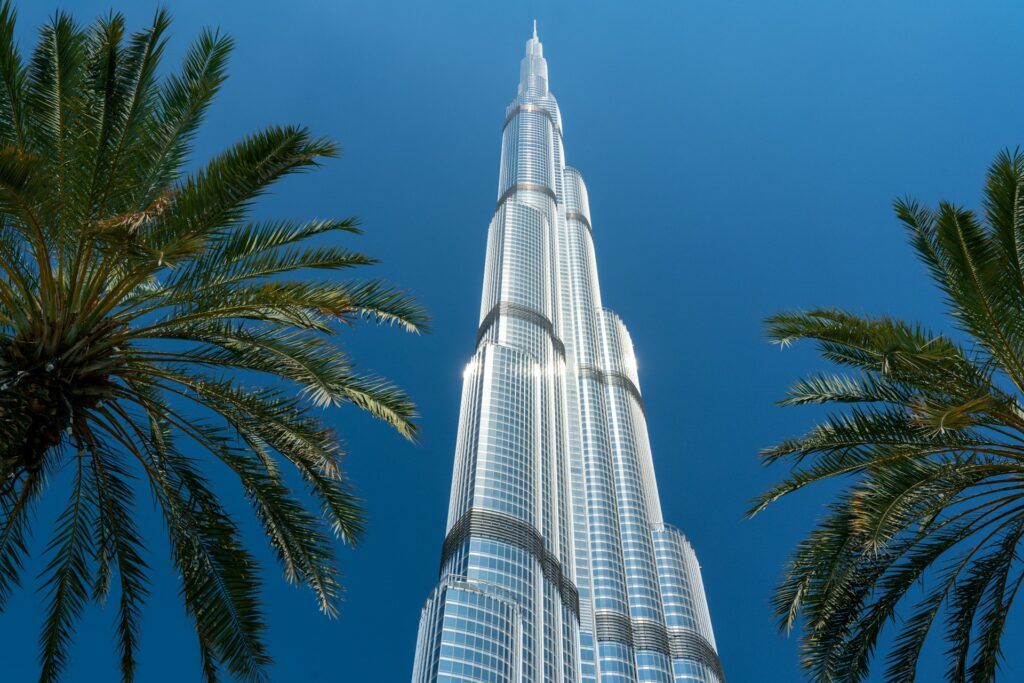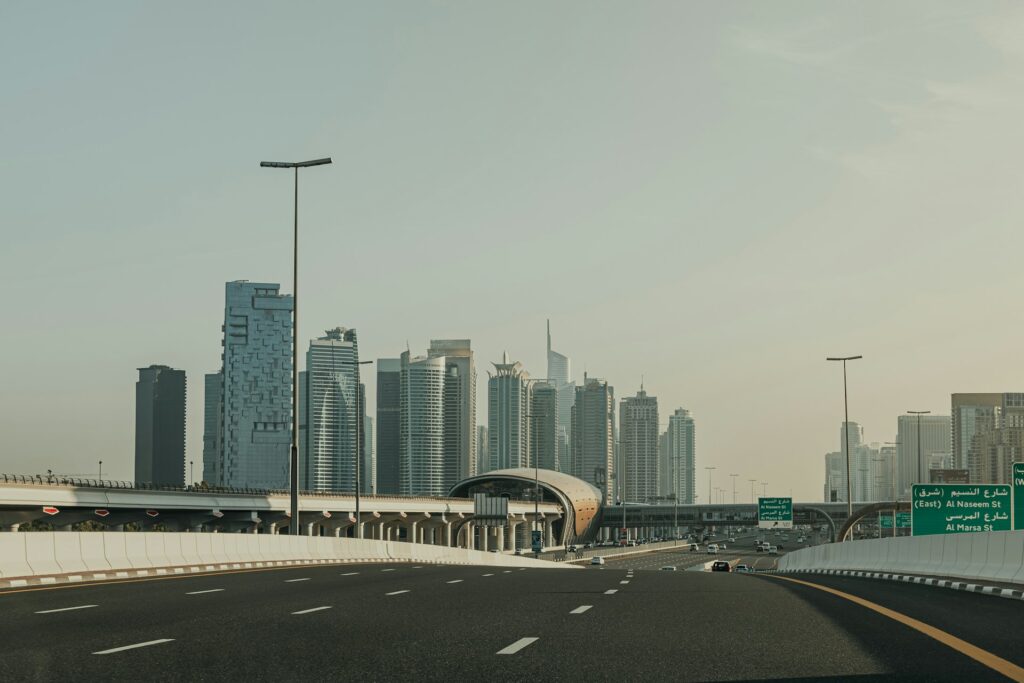
- General driving tips for Dubai
- Speed limits
- Passing and turning
- Parking
- Right of way
- Driver’s license requirements
- Toll roads
- Emergency numbers
- Dubai car rental with SIXT
Dubai has one of the best road networks in the world, and driving here is an exhilarating experience. Being in a car opens a whole new side of the city for you to see, one that goes beyond the glances from a cab window or the blurred sights you see as you speed through the city on the metro. As exciting as it might be driving in Dubai, the experience may be daunting, especially for people new to the United Arab Emirates. There’s a lot to keep in mind as you navigate the city, so here are some driving tips for Dubai.
General driving tips for Dubai
You’ll drive on the right side of the road, so if you come from a country where you drive on the left, it’s a good idea to rent an automatic vehicle so that you don’t need to get used to changing gears with your unfamiliar hand. As in many other countries, all passengers must wear seat belts, front and back. The fine for not wearing a seat belt is $110 (AED 400).
Along with driving on the right, remember that the left-most lane on dual or multiple-lane highways is the fast lane in Dubai. Unless you intend to stick to the upper limit of the speed allowed, stick to the slower right lanes. And always keep a safe distance when driving—maintain at least a five-second gap between you and the car in front.
Children under the age of four must sit in a secure child seat, and front passengers must be at least 145 cm (57 inches) tall and when under the age of 10. Failure to comply with these regulations will net you a $110 (AED 400) fine.
While everyone can drink in Dubai it is absolutely out of the question to drink and drive in Dubai. There is a zero-tolerance policy for any level of alcohol in the blood. You risk an almost certain jail sentence for breaking this law.
As in most countries, watch for emergency vehicles with flashing lights stopped on the road or shoulders. Slow down and pass with caution, and always be ready to stop when you come across emergency vehicles or staff on the road. Always give way to emergency vehicles and never tailgate, race or pass an emergency vehicle with flashing lights.
Speed limits
The speed limits in Dubai are in kilometers per hour and not miles per hour. It’s densely covered by traffic cameras and radars to catch speeding drivers. Be cautious, and always stick to the speed limit. If someone near you is speeding, pull over or maintain your speed and let them go around you. Dubai is something of a supercar playground, so always keep a sharp eye out for someone taking theirs out to stretch its legs, and make sure not to drive in the left-most fast lane.

Like most other countries, speed limits in Dubai depend on the type of road you’re driving on.
- Major highways – between 60-70 mph (100-120 km/h)
- Urban roads – between 40-50 mph (60-80 km/h)
- Residential areas and small suburban roads – between 15-25 mph (25-40 km/h).
These are the standard speed limit ranges, but you need to check the signs on every major road, as they can differ from one to the other. For example, the speed limit on Dubai’s busiest highway, Sheikh Zayed Road, is 60-75 mph (100-120 km/h), on Emirates Road it’s 70-75 mph (110-120 km/h), and on Al Khail Road it’s 60 mph (100 km/h).
The Dubai Police website has a detailed list of speed limits on all main roads in Dubai.
Passing and turning
When driving in Dubai, stay safe and be considerate of other road users by complying with local driving regulations and customs.
Passing: Since driving is on the right in Dubai, ensure that you always pass from the left. If you’re changing lanes, ensure that you check all three mirrors and do a shoulder check to confirm that the road is clear. Turn on your indicator signal to communicate with drivers behind you, then change lanes.
Turning: Do not turn right at a red light unless there is a yield sign. Only maneuver in dedicated lanes. For instance, do not make a U-turn at non-dedicated U-turn lanes.
Parking
In the Dubai city center, you have the option of street parking and parking garages. Garage parking is much easier to come by than street parking. You can pay for street parking at the parking meters or use the parking mobile app, which also warns you when your ticket is about to expire. Parking is prohibited where the curb is painted yellow and black. Special parking arrangements are made for disabled drivers with reserved spots on the streets and in parking garages.
Right of way
The following have right of way in these specific situations:
- Pedestrians at a designated pedestrian crossing.
- Vehicles that are on major roads at T-junctions.
- Vehicles coming along the road when you’re pulling out of a parking spot.
- Vehicles on a major road if you’re approaching from a minor road.
- Stop and give way to children boarding or alighting from a school bus with flashing lights.
- Emergency vehicles and military convoys.
- The vehicle that arrives first at a traffic junction or traffic circle with no traffic signals.
Driver’s license requirements
If you intend to rent a car in Dubai, you need to have both the driver’s license issued in your own country and an International Driving Permit (IDP). You must also carry your passport with you when driving. It’s not required by law to carry vehicle registration documents or proof of insurance. Also remember that although the minimum age for driving in Dubai is 17, you’ll generally need to be at least 21 to get a rental car. Find here more detailed information on the important documents for renting a car.
Toll roads
To pay for tolls in Dubai, you’ll need to register with the Salik toll system and attach the Salik tag to your windshield. When you drive through the toll gates, the tag is scanned, and toll fees are electronically deducted so you don’t have to stop to pay. Salik tags are available at gas stations.
The Salik toll gates are at the following locations:
- Al Barsha
- Al Garhoud Bridge
- Business Day Crossing
- Al Maktoum Bridge
- Al Mamzar South
- Al Mamzar North
- Al Safa South
- Al Safa North
Emergency numbers
In the case of a roadside emergency, you can call any of the following numbers while in Dubai, as per official government information:
- Police – 999
- Ambulance – 998
- Fire department – 997
- Coast Guard – 996
- Search and Rescue – 995
- Electrical Failures – 991
The DCAS SOS app for emergency ambulance services is also handy for drivers in Dubai. The app comes with an SOS feature that determines your exact location.
Dubai car rental with SIXT
With these driving tips for Dubai, you can confidently choose a Dubai car rental from SIXT. We have several locations at major travel hubs downtown, like Sheikh Zayed Road, and at Dubai International Airport. You can get your own set of wheels as soon as you arrive. From convertibles to SUVs to luxury rentals, SIXT Dubai has it all. If you’re going to be exploring the incredible UAE deserts, we recommend an all-wheel-drive vehicle and a GPS add-on. Convertibles are great, especially if you’re looking to feel the coastal breeze in your hair. With a SIXT car rental, the historical Al Fahidi neighborhood, Hatta Heritage Village, and Burj Khalifa are all within reach to visit in your own time, at your own pace.